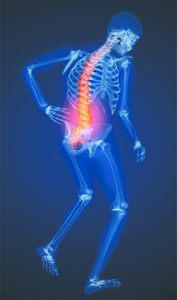 Many patients suffering from chronic back or neck pain that has not sufficiently responded to other medical treatments find relief from a device called a spinal cord stimulator, or SCS. A SCS is a surgically-placed implant that works by delivering a mild electrical current to the epidural space of the spine, subduing the pain signals that damaged, overactive nerves send to the brain. Somewhat like a “pacemaker for pain,” SCS devices are FDA-approved to treat chronic pain caused by sciatica, arthritis, spinal stenosis, failed back surgery syndrome, neuropathy, cervical/lumbar radiculitis, complex regional pain syndrome, reflex sympathetic dystrophy and other disorders.
Many patients suffering from chronic back or neck pain that has not sufficiently responded to other medical treatments find relief from a device called a spinal cord stimulator, or SCS. A SCS is a surgically-placed implant that works by delivering a mild electrical current to the epidural space of the spine, subduing the pain signals that damaged, overactive nerves send to the brain. Somewhat like a “pacemaker for pain,” SCS devices are FDA-approved to treat chronic pain caused by sciatica, arthritis, spinal stenosis, failed back surgery syndrome, neuropathy, cervical/lumbar radiculitis, complex regional pain syndrome, reflex sympathetic dystrophy and other disorders.
Though this form of drug-free treatment has been in use for decades, it is gaining popularity as more people wish to reduce or eliminate pain medication, and advances in technology have made these devices smaller and less invasive, and more compatible with imaging systems like MRI. Currently, approximately 14,000 patients worldwide receive SCS implants each year, and most report a significant reduction in pain and improvement in function, but in order to gain the most benefit, a patient must have their condition and case thoroughly reviewed to assess the appropriateness of this therapy over others, including the cause of pain, other treatments that have failed, how long the pain has lasted, medications being taken and overall health.
“A screening trial must be performed to assess the possible effectiveness of SCS for each patient,” says Board Certified neurosurgeon Dr. Mark Oliver. “The screening trial allows patients to test their potential satisfaction with SCS before they opt for surgery and long-term therapy.”
The screening trial involves inserting a narrow electrical lead through a small incision in the skin and guiding it into the spinal epidural space to address the affected area. The other end of the lead is connected to a small neurostimulator that fits in a pouch the patient wears on his or her waistband. The patient controls the level of electrical stimulation via a wireless remote control.
Should the patient find the stimulation insufficient or uncomfortable, the electrical lead can easily be removed in-office without lasting negative effects. “Patients who respond favorably to the screening trial generally receive the most relief and long-term
satisfaction,” says Dr. Oliver. “It’s a rare situation that a patient can try out the results of a surgery before they have it, so that’s a big positive with SCS.”
While an SCS device will not get rid of pain completely, most patients who respond well to the screening trial report that SCS therapy helps to manage their pain and promote better functioning with daily activities.
Spinal Cord Stimulator Surgery
SCS surgery is performed as follows:
. You will be placed under general anesthesia, and then positioned facedown on the operating table.
. After applying a topical numbing agent, your ONC neurosurgeon will make a small incision in your back and use x-ray image guidance to place the electrical leads where they can deliver stimulation to the epidural space of the spinal cord.
. He will make a second incision in the upper buttock, where the generator can be inserted without getting in your way.
. Once the leads have been connected to the generator, the incisions are closed and the surgery is complete, usually in less than one hour.
. Recovery from SCS surgery typically takes a few weeks.
Your ONC surgical team will advise you about when you should attempt physical activities.
. Once installed, you can adjust the amount of electrical
stimulation you receive, from none at all to maximum current, as you need it.
If you have chronic back, neck or limb pain due to damaged nerves, talk to your doctor about the potential benefits and risks of Spinal Cord Stimulation surgery, or contact ONC for more information.
MARK D. OLIVER, MD
• In practice of neurosurgery since joining Ocala Neurosurgery Center in 1998
• Board Certified in Neurological Surgery by the American Board of Neurological Surgery
• Medical Degree from the University of Alabama School of Medicine in Birmingham, AL
• Chief Resident at the University of South Florida College of Medicine in Tampa with specialized training in complex spinal disorders
• Fellowship in neuroscience spinalcord injury at Eastern Virginia School of Medicine in Norfolk, Virginia
• Certified by the National Board of Medical Examiners
• On staff at Munroe Regional Medical Center & Ocala Regional Medical Center
Dr. Oliver is a member of the American Association of Neurological Surgeons, the Florida Neurological Society, the Florida Medical Association and the Marion County Medical Society.
Dr. Mark Oliver, his partner neurosurgeons, Dr. Daniel Robertson and Dr. Antonio DiSclafani, and their talented support team are dedicated to providing unsurpassed diagnostic and therapeutic care for a range of neurological and spinal disorders. Our foremost mission is to help you return to a life of health, comfort and vitality.
Check Also
CUSTOMIZABLE LIGHT ADJUSTABLE LENS A GAMECHANGER FOR CATARACTS PATIENTS
All Americans have some degree of cataract change by the age of 75. As the …
 Central Florida Health and Wellness Magazine Health and Wellness Articles of the Villages
Central Florida Health and Wellness Magazine Health and Wellness Articles of the Villages



